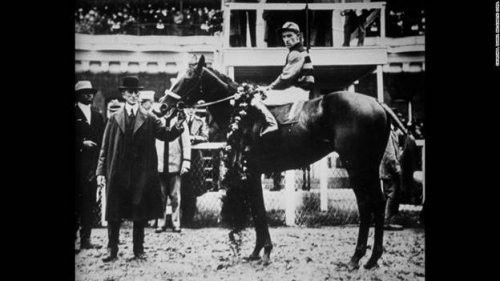Countdown to the Kentucky Derby - 100 days to go!

100 Days!!! 1919 Sir Barton became the first official Triple Crown winner, although it wouldn't be recognized as the Triple Crown until 1930 when Charles Hatton of the Daily Racing Form put the term into common use to describe Gallant Fox's run.
Sir Barton was bred by John E. Madden in partnership with the English trainer, Vivian Gooch. Madden had imported the stallion, *Star Shoot, who was a son of the English Triple Crown winner, Isinglass. *Star Shoot became the most successful sire in the United States after only 2 years of stud duty. The partnership bred the Hanover mare, Lady Sterling, to Madden’s prized stallion; the result was a chestnut colt that Madden named after notorious Scottish sea captain, Sir Andrew Barton. Madden later bought Gooch’s shares while Sir Barton was a weanling, owning the colt in entirety when he made his first start.
While with Madden, Sir Barton was trained by W. S. Walker for his first four starts at two. At Saratoga, John Kenneth Leveson (J.K.L.) Ross was with his trainer, H. Guy Bedwell, when they saw Sir Barton. He had just finished unplaced in his fourth start, however, the two men wanted the colt, paying Madden $9,500 or $10,000, with an agreement that should he win the Futurity, they split the prize money.Starting two more times at two for the team of Ross and Bedwell, Sir Barton’s best finish would be a 2nd in the 1918 Belmont Futurity. He was sidelined for the remainder of his 2YO season because of blood poisoning that he contracted from a cut that was the result of another horse kicking him in the hind leg.
Sir Barton, or “Sammy” as he was known around the barn, was a horse with soft hooves and a nasty temper. No one ever knew if his attitude had to do with his soft hooves, all they knew was that he didn’t like other animals or people. The only person the colt ever tolerated was his groom, “Toots” Thompson, who loved the ornery colt.
Sir Barton’s soft feet had to be shod with piano felt between his shoe and hoof. Due to the condition, he was prone to lose one or two shoes in his races. When he ran in the Dwyer, he returned after finishing second, having lost all four. 1918 would see the major races having a ban on geldings, in an effort to curtail owners from gelding their horses. The reason was that the military was in desperate need of mounts, so breeding stallions were a big commodity. The ban was lifted the following year as the gelding, Paul Jones, would win the Kentucky Derby.
Ross had another contender for the Derby in 1918, Billy Kelly, who would go on to be one of the nation’s top sprinters. Sir Barton’s jockey, Johnny Loftus, was given directions to set the pace for Billy Kelly, who was then supposed to overtake the pair to win the race. Sir Barton was assigned the light weight of 110, as he was a maiden. Loftus, however, couldn’t make the impost, so they went to the start carrying 112 ½ pounds. This was the last year that the Derby was run at such weight, as they would then raise it to the 126 pounds for all (fillies carry 121). To this day, that weight remains.
The night before the big race, it rained throughout, leaving a muddy track. It did little to chase off the contenders, as 12 horses would go to post. 50,000 bodies packed the track, even though the infield was not free. The 83 pari-mutuel machines were put to heavy work from the giant crowd. As planned, Sir Barton broke on top, carrying an easy lead to the top of the stretch. At the 16th pole Loftus looked around for Billy Kelly. The colt was back, making his way into second, however Loftus couldn’t spot him through the mud. Knowing he was on a ton of horse, he thought to he#% with them. Giving the colt one pop, they took off, speeding away from the rest of the field. Loftus hand-rode the colt to an easy five-length win, stopping the watch in 2:09 4/5 over the track rated as heavy. His stablemate, Billy Kelly, would hold on to finish second, giving the Ross stable the first 1-2 finish in Derby history.
The Preakness was run four days after the Kentucky Derby, on May 13th. Again facing a field of 11 others, Sir Barton again won in wire-to-wire fashion, this time on a fast track. A mere 10 days later, on May 24th, Sir Barton would contest the one mile Withers Stakes, taking over after ¾ of a mile to win by 3 lengths. In the Belmont, he would only have two challengers, Natural Bridge and Sweep On, both owned by W.R. Coe. Coe’s plan was to have Natural Bridge set the pace, wearing Sir Barton out, while Sweep On took over to win the race. However, when Natural Bridge tired, it was Sir Barton that took over, beating the pair by five lengths and setting an American record for the then mile and 3/8 race, in 2:17 2/5.
In the course of 32 days, the maiden pacesetter won four races, as well as the distinction of being the first Triple Crown winner when the term originated. As a result of his brilliant 1919 campaign, he was named 3YO Champion as well as Horse of the Year. At 4 Sir Barton would beat Exterminator in the Saratoga Handicap, setting a track record of 2:01 4/5 for the mile and a quarter while carrying 133 pounds. He won three other stakes, setting an American record of 1:55 3/5 for 9 and ½ furlongs, again at Saratoga.
Unfortunately for the majority of horses in 1920, their accomplishments got eclipsed by the presence of the great Man O’ War. Sir Barton would take on Man O’ War in a famous match race. Unfortunately, the hard track condition would cause Sir Barton’s feet to become sore, causing him to lose the match to Man O' War by seven lengths.
Once retired, he sired a few foals before being sold for $75,000 to B. B. and Montfort Jones. From Kentucky, he was sent to Virginia to their farm, where he stood through 1932. At stud he did sire 1928 Kentucky Oaks and 3YO Champion filly, Easter Stockings, as well as six other stakes winners, otherwise he wasn't considered much of a success. He became a sire for the U.S. Army Remount Service, eventually being purchased by thoroughbred breeder J.R. Hylton for his farm in Wyoming. He is buried at Washington Park in Douglas, Wyoming.
From the History of the Kentucky Derby, 1875-1921: "A record Derby in more ways than one was this year's Louisville's big racing attraction. Never was there such a crowd, the dimensions of which reminded me of Epsom and of Flemington. A vast surging mass of racing enthusiasts, which, prior to the running of the big race, were to be found eagerly discussing the merits or demerits of the Derby contestants and afterwards the whys and wherefores of the success of one and the failure of others. A record Derby also because of the fact that two horses in the same ownership finished first and second, and also for the first time in its history the spoils fell to a sportsman who hails from the land of "God save the king and heaven bless the maple leaf forever."



